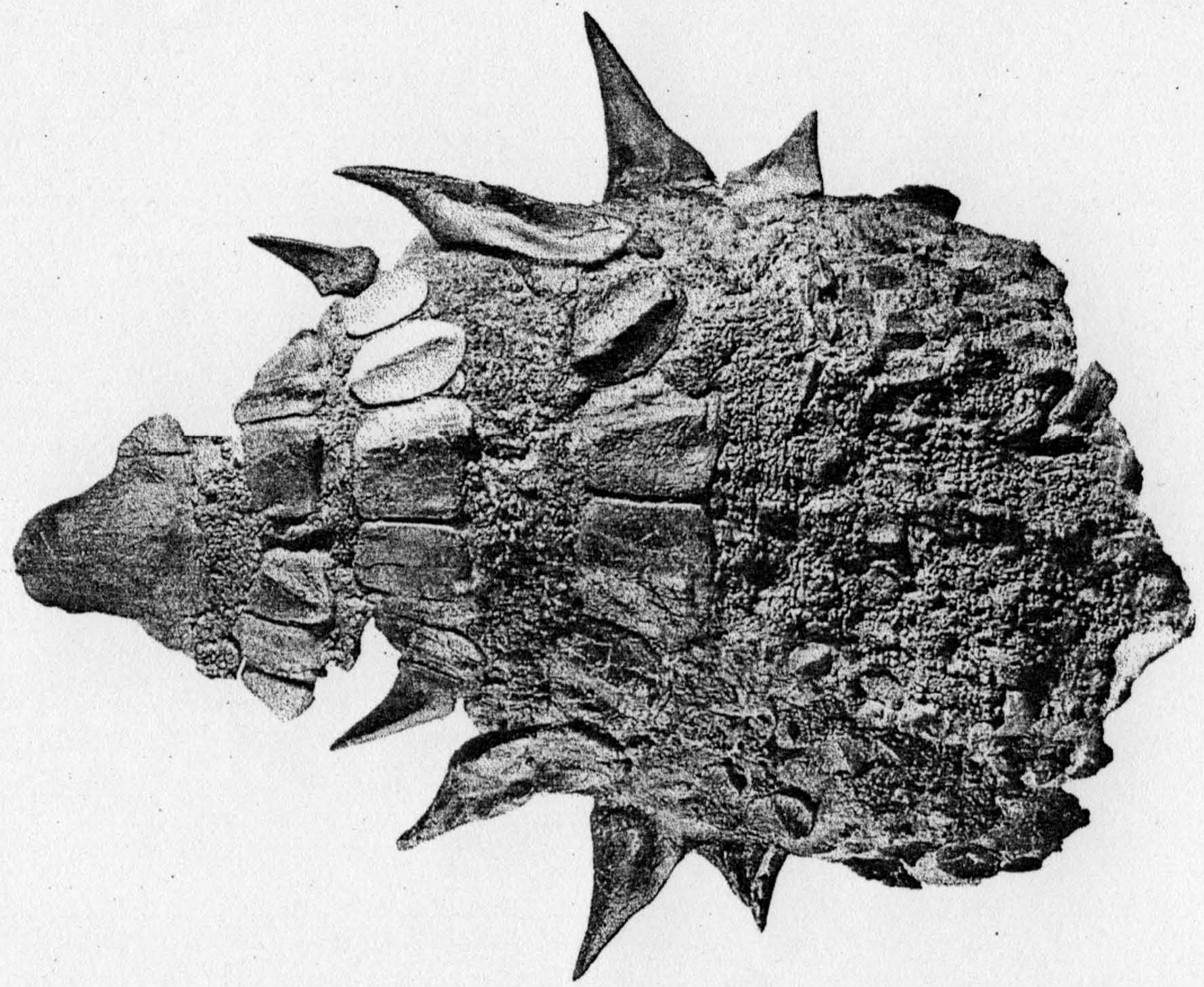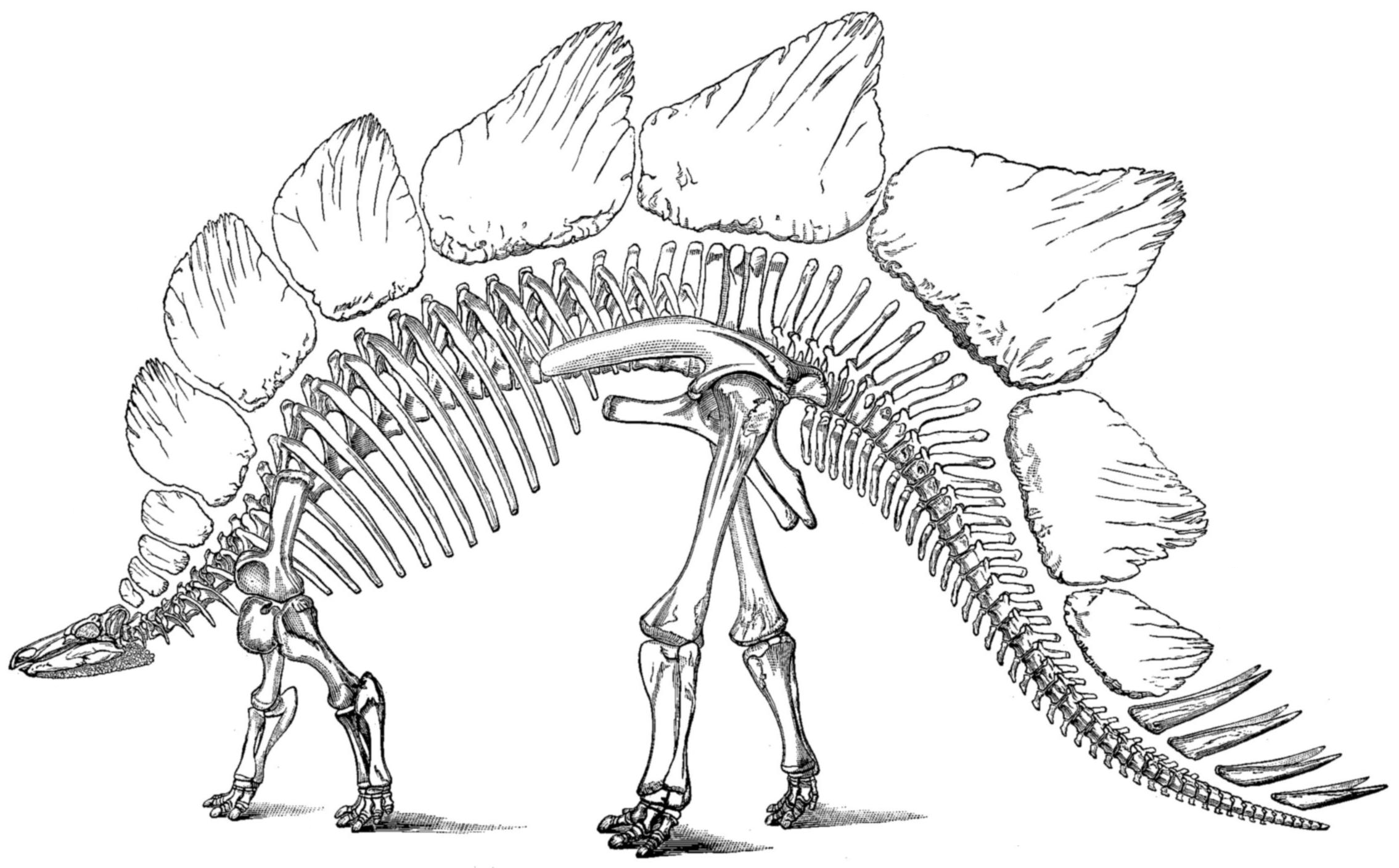|
Sarcolestes
''Sarcolestes'' (meaning "flesh robber") is an extinct genus of ankylosaurian ornithischian dinosaur from the Oxford Clay of England. The current type and only species is ''S. leedsi'', and the holotype is a single partial left mandible. The genus and species were named in 1893 by Richard Lydekker, who thought they belonged to a theropod. Discovery ''Sarcolestes'' was first named in 1893 by Richard Lydekker, and its type species was designated as ''S. leedsi''. The specific name was to honour Alfred Nicholson Leeds, the discoverer of the specimen, and many others like it. The holotype and only specimen, is a partial left mandible and fused scute that was damaged during excavation. The jaw preserved one entire tooth and two crown tips in its alveolus, with the missing bone in the central section of the mandible. It lacks a preserved predentary, even though the entire mandibular symphysis is preserved and complete. Classification Originally, Lydekker found that ''Sarcolestes ... [...More Info...] [...Related Items...] OR: [Wikipedia] [Google] [Baidu] |
Spicomellus
''Spicomellus'' (meaning "collar of spikes") is an extinct genus of herbivorous ankylosaurian dinosaur that lived in the supercontinent Gondwana during the Middle Jurassic Period. The type and only known species is ''Spicomellus afer'', named and described in 2021. Its remains were found in the third subunit of the El Mers Group (Bathonian- Callovian), near Boulahfa, south of Boulemane, Fès-Meknès, Morocco. The genus name means "spiked collar", from the Latin 'spica' meaning spike, and 'mellum' meaning spiked dog collar and the specific name 'afer' means "the African". During the Jurassic, eurypodan dinosaurs, in particular stegosaurs, were diverse and abundant in Laurasia (nowadays the northern continents), but their remains are extremely rare in Gondwanan deposits, nowadays the southern continents. Nevertheless, the existence of fragmentary remains and trackways in the deposits of Gondwana indicates the presence of eurypodan taxa there. ''Spicomellus'' is the second descri ... [...More Info...] [...Related Items...] OR: [Wikipedia] [Google] [Baidu] |
1893 In Paleontology
Arthropods Newly named insects Fish Newly named Ray-finned fish Archosauromorphs Newly named dinosaurs Plesiosaurs New taxa Synapsids Non-mammalian References {{portal, Paleontology ... [...More Info...] [...Related Items...] OR: [Wikipedia] [Google] [Baidu] |
Nodosauridae
Nodosauridae is a family of ankylosaurian dinosaurs, from the Late Jurassic to the Late Cretaceous period in what is now North America, South America, Europe, and Asia. Description Nodosaurids, like their close relatives the ankylosaurids, were heavily armored dinosaurs adorned with rows of bony armor nodules and spines (osteoderms), which were covered in keratin sheaths. All nodosaurids, like other ankylosaurians, were medium-sized to large, heavily built, quadrupedal, herbivorous dinosaurs, possessing small, leaf-shaped teeth. Unlike ankylosaurids, nodosaurids lacked mace-like tail clubs, instead having flexible tail tips. Many nodosaurids had spikes projecting outward from their shoulders. One particularly well-preserved nodosaurid "mummy", known as the Suncor nodosaur (''Borealopelta markmitchelli''), preserved a nearly complete set of armor in life position, as well as the keratin covering and mineralized remains of the underlying skin, which indicate reddish dorsal pigm ... [...More Info...] [...Related Items...] OR: [Wikipedia] [Google] [Baidu] |
Ankylosauria
Ankylosauria is a group of herbivorous dinosaurs of the order Ornithischia. It includes the great majority of dinosaurs with armor in the form of bony osteoderms, similar to turtles. Ankylosaurs were bulky quadrupeds, with short, powerful limbs. They are known to have first appeared in the Middle Jurassic, and persisted until the end of the Cretaceous Period. The two main families of Ankylosaurs, Nodosauridae and Ankylosauridae are primarily known from the Northern Hemisphere, but the more basal Parankylosauria are known from southern Gondwana during the Cretaceous. Ankylosauria was first named by Henry Fairfield Osborn in 1923.Osborn, H. F. (1923). "Two Lower Cretaceous dinosaurs of Mongolia." ''American Museum Novitates'', 95: 1–1/ref> In the Linnaean classification system, the group is usually considered either a suborder or an infraorder. It is contained within the group Thyreophora, which also includes the stegosaurs, armored dinosaurs known for their combination of p ... [...More Info...] [...Related Items...] OR: [Wikipedia] [Google] [Baidu] |
Oxford Clay
The Oxford Clay (or Oxford Clay Formation) is a Jurassic marine sedimentary rock formation underlying much of southeast England, from as far west as Dorset and as far north as Yorkshire. The Oxford Clay Formation dates to the Jurassic, specifically, the Callovian and Oxfordian ages, and comprises two main facies. The lower facies comprises the Peterborough Member, a fossiliferous organic-rich mudstone. This facies and its rocks are commonly known as lower Oxford Clay. The upper facies comprises the middle Oxford Clay, the Stewartby Member, and the upper Oxford Clay, the Weymouth Member. The upper facies is a fossil poor assemblage of calcareous mudstones. Oxford Clay appears at the surface around Oxford, Peterborough and Weymouth and is exposed in many quarries around these areas. The top of the Lower Oxford Clay shows a lithological change, where fissile shale changes to grey mudstone. The Middle and Upper Oxford Clays differ slightly, as they are separated by an argillaceo ... [...More Info...] [...Related Items...] OR: [Wikipedia] [Google] [Baidu] |
Alfred Nicholson Leeds
Alfred Nicholson Leeds (9 March 184725 August 1917) was an English amateur palaeontologist. Biography Leeds was born at Eyebury, Peterborough, the youngest of the eight children of Edward Thurlow Leeds (180251) and Eliza Mary Leeds (née Nicholson). He was educated at Warwick School. He had wanted to become a doctor, but circumstances meant that from 1868 he had to take on the management of Eyebury Farm (in The Fens, and historically attached to Peterborough Abbey) as a gentleman farmer. His elder brother Charles, a student at the University of Oxford, had been encouraged by Professor John Phillips to persevere in collecting fossils from near his home. Alfred joined him in these searches, and between them they developed better methods of disinterring, and of scientifically recording, fossils in soft clay than had been used before. (They rewarded the workmen at the clay pits (which served a brickworks in Fletton, Peterborough) for not doing so themselves, but instead sending no ... [...More Info...] [...Related Items...] OR: [Wikipedia] [Google] [Baidu] |
Priodontognathus
''Priodontognathus'' (meaning " saw tooth jaw") was a genus of ankylosaurian dinosaur possibly from the Oxfordian-age Upper Jurassic Lower Calcareous Grit of Yorkshire, England. It is a dubious genus based on a maxilla, and has been erroneously mixed up with iguanodonts and stegosaurs. History and taxonomy English paleontologist Harry Govier Seeley, who described the genus, first mentioned the holotype (SMC B53408), a maxilla or upper jaw bone, in 1869.Seeley, H.G. (1869). ''Index to the fossil remains of ''Aves, Ornithosauria'', and ''Reptilia'' from the Secondary Strata.'' Cambridge University Press:Cambridge, 143 p. Seeley was at the time compiling a catalogue of the fossils of the Woodwardian Museum. Part of these formed the Forbes Collection that after the death of James Forbes-Young had in 1862 been donated to the University of Cambridge by his sons Charles Young and Henry Young. The provenance of this particular bone from that collection was unknown; first believed ... [...More Info...] [...Related Items...] OR: [Wikipedia] [Google] [Baidu] |
Franz Nopcsa
Franz may refer to: People * Franz (given name) * Franz (surname) Places * Franz (crater), a lunar crater * Franz, Ontario, a railway junction and unorganized town in Canada * Franz Lake, in the state of Washington, United States – see Franz Lake National Wildlife Refuge Businesses * Franz Deuticke, a scientific publishing company based in Vienna, Austria * Franz Family Bakeries, a food processing company in Portland, Oregon * Franz-porcelains, a Taiwanese brand of pottery based in San Francisco Other uses * ''Franz'' (film), a 1971 Belgian film * Franz Lisp, a dialect of the Lisp programming language See also * Frantz (other) * Franzen (other) Franzen or Franzén is a Scandinavian surname. Notable people with the surname include: * Anders Franzén (1918–1993), Swedish underwater archaeologist *Arno Franzen, Brazilian rower * Arvid Franzen (1899–1961), Swedish-American accordionist an ... * Frantzen (other) {{disambiguation ... [...More Info...] [...Related Items...] OR: [Wikipedia] [Google] [Baidu] |
Stegosauridae
Stegosauridae is a family of thyreophoran dinosaurs (armoured dinosaurs) within the suborder Stegosauria. The clade is defined as all species of dinosaurs more closely related to ''Stegosaurus'' than ''Huayangosaurus''.David B. Weishampel, Peter Dodson, Halszka Osmólska. The ''Dinosauria'' (2nd ed.). Berkeley: University of California Press. The name ‘Stegosauridae’ is thus a stem-based name taken from the well-represented genus – ''Stegosaurus'' (meaning ‘roofed lizard’). Fossil evidence of stegosaurids, dating from the Middle Jurassic through the Early Cretaceous, have been recovered from North America, Eurasia and Africa. The clade Stegosauridae is composed of the genera ''Stegosaurus'', '' Dacentrurus'', '' Miragaia'', '' Loricatosaurus'', and '' Kentrosaurus'', with the last considered to be at the base of the clade. The stegosaurids like all other stegosaurians were quadrupedal herbivores that exhibited the characteristic stegosaurian dorsal dermal plates. These ... [...More Info...] [...Related Items...] OR: [Wikipedia] [Google] [Baidu] |
Polacanthus
''Polacanthus'', deriving its name from the Ancient Greek polys-/πολύς- "many" and akantha/ἄκανθα "thorn" or "prickle", is an early armoured, spiked, plant-eating ankylosaurian dinosaur from the early Cretaceous period of England. In the genus ''Polacanthus'' several species have been named but only the type species ''Polacanthus foxii'' is today seen as valid. ''Polacanthus'' was a quadrupedal ornithischian or "bird-hipped" dinosaur. It lived 130 to 125 million years ago in what is now western Europe.Holtz, Thomas R. Jr. (2012) ''Dinosaurs: The Most Complete, Up-to-Date Encyclopedia for Dinosaur Lovers of All Ages,''https://www.geol.umd.edu/~tholtz/dinoappendix/appendix.html ''Polacanthus foxii'' was named after a find on the Isle of Wight in 1865. There are not many fossil remains of this creature, and some important anatomical features, such as its skull, are poorly known. Early depictions often gave it a very generic head as it was only known from the rear half o ... [...More Info...] [...Related Items...] OR: [Wikipedia] [Google] [Baidu] |
Hylaeosaurus
''Hylaeosaurus'' ( ; Greek: / "belonging to the forest" and / "lizard") is a herbivorous ankylosaurian dinosaur that lived about 136 million years ago, in the late Valanginian stage of the early Cretaceous period of England. It was found in the Grinstead Clay Formation. ''Hylaeosaurus'' was one of the first dinosaurs to be discovered, in 1832 by Gideon Mantell. In 1842 it was one of the three dinosaurs Richard Owen based the Dinosauria on, the others being '' Iguanodon'' and ''Megalosaurus''. Four species were named in the genus, but only the type species ''Hylaeosaurus armatus'' is today considered valid. Only limited remains have been found of ''Hylaeosaurus'' and much of its anatomy is unknown. It might have been a basal nodosaurid, although a recent cladistic analysis recovers it as a basal ankylosaurid. ''Hylaeosaurus'' was about five metres long. It was an armoured dinosaur that carried at least three long spines on its shoulder. History of discovery The first ... [...More Info...] [...Related Items...] OR: [Wikipedia] [Google] [Baidu] |
Stegosaurus
''Stegosaurus'' (; ) is a genus of herbivorous, four-legged, armored dinosaur from the Late Jurassic, characterized by the distinctive kite-shaped upright plates along their backs and spikes on their tails. Fossils of the genus have been found in the western United States and in Portugal, where they are found in Kimmeridgian- to early Tithonian-aged strata, dating to between 155 and 145 million years ago. Of the species that have been classified in the upper Morrison Formation of the western US, only three are universally recognized: ''S. stenops'', ''S. ungulatus'' and ''S. sulcatus''. The remains of over 80 individual animals of this genus have been found. ''Stegosaurus'' would have lived alongside dinosaurs such as ''Apatosaurus'', '' Diplodocus'', '' Brachiosaurus'', '' Ceratosaurus'', and ''Allosaurus''; the latter two may have preyed on it. They were large, heavily built, herbivorous quadrupeds with rounded backs, short fore limbs, long hind limbs, and tails held ... [...More Info...] [...Related Items...] OR: [Wikipedia] [Google] [Baidu] |







